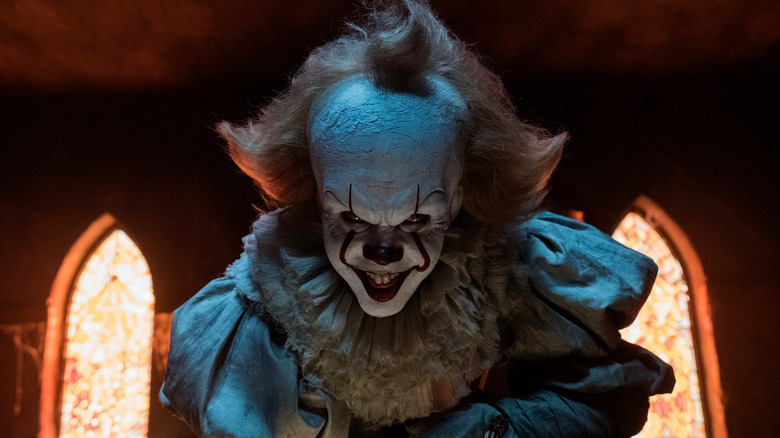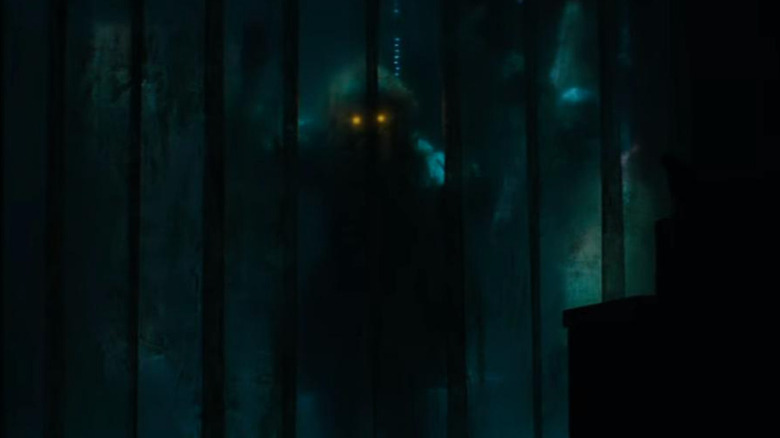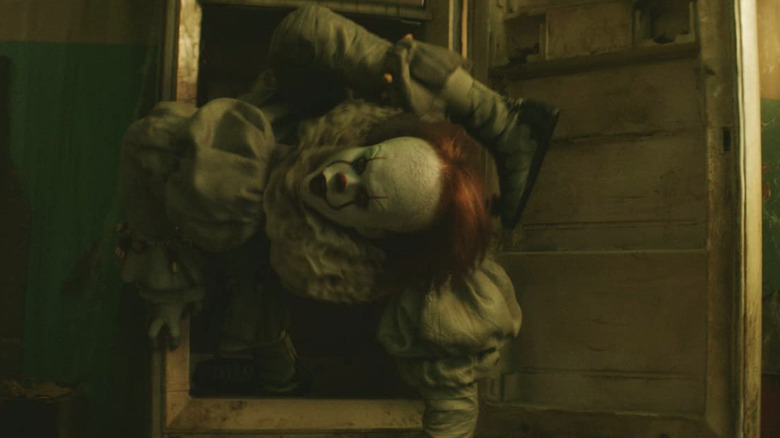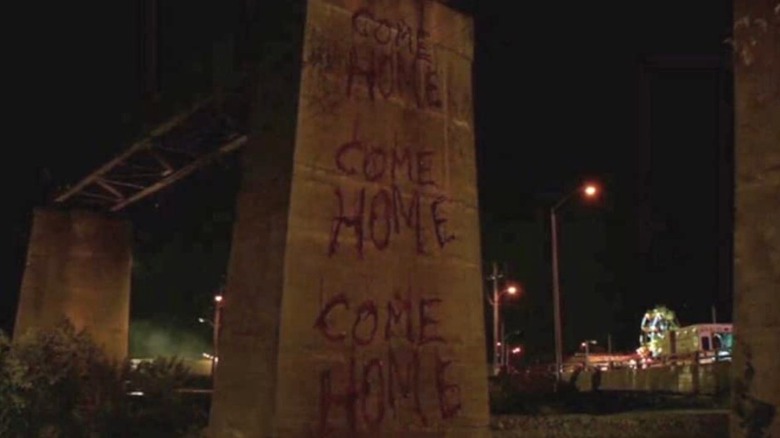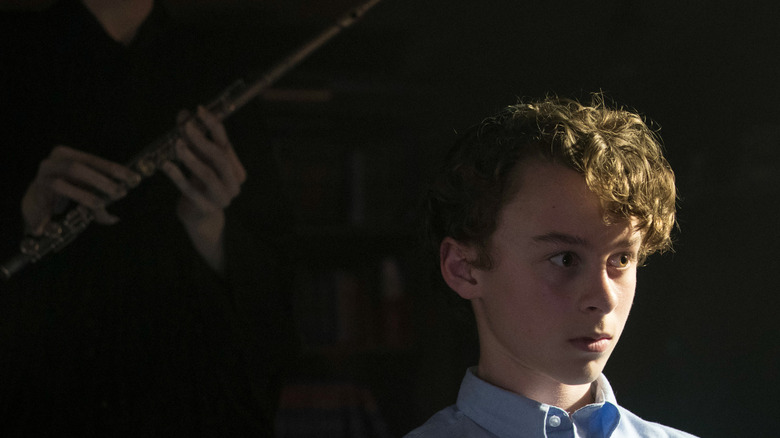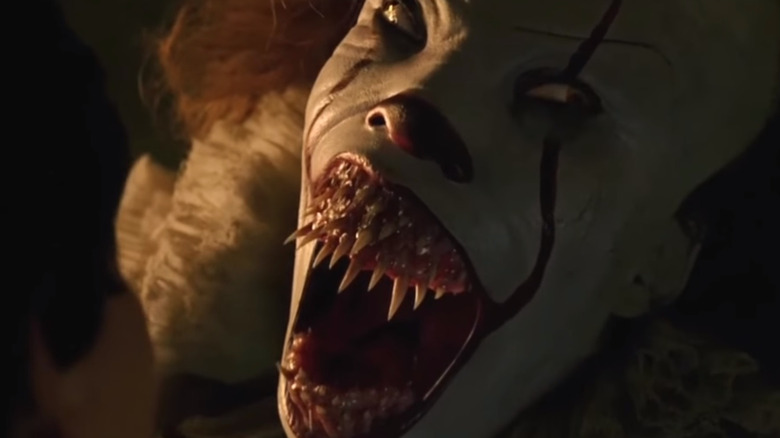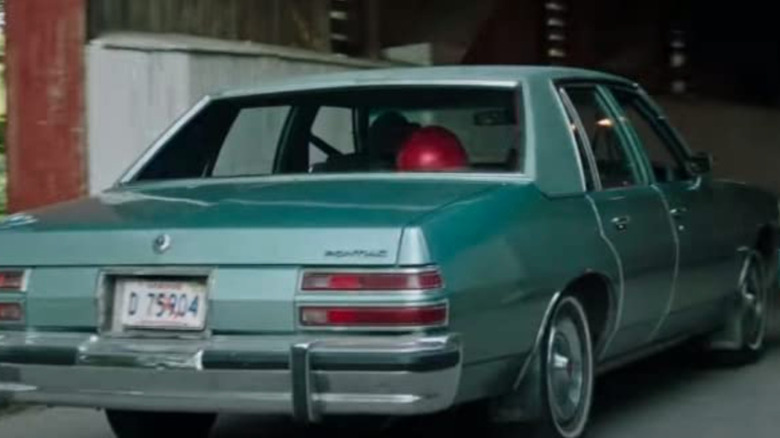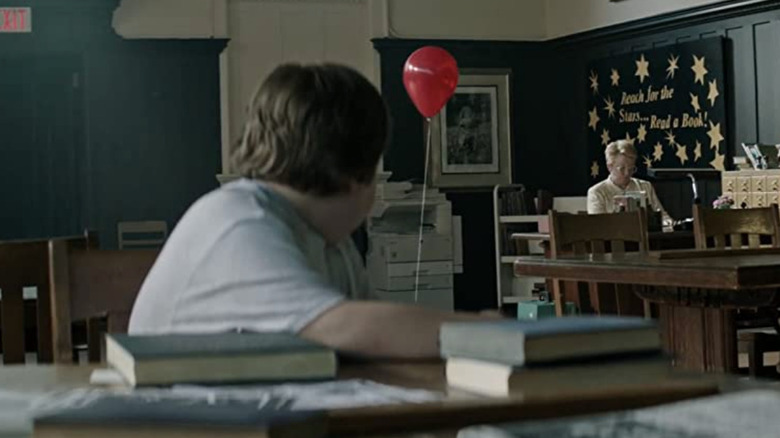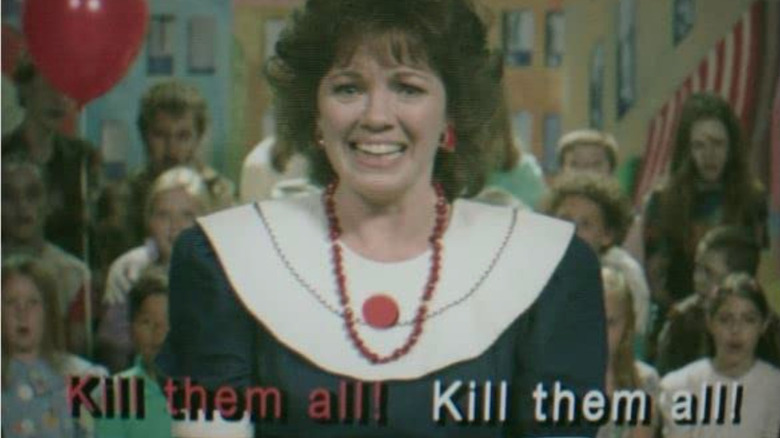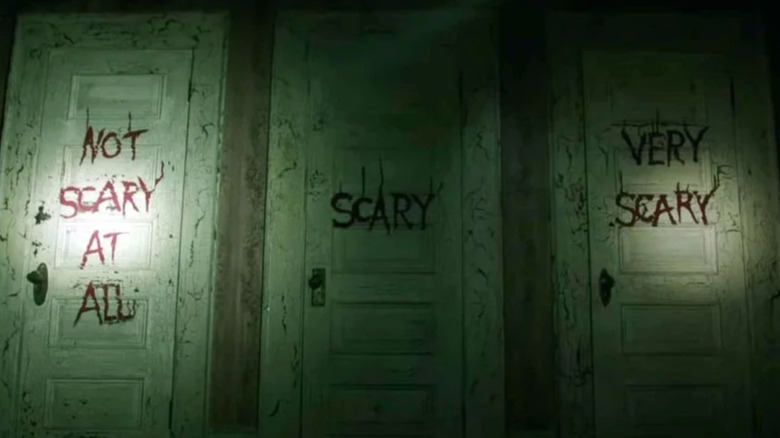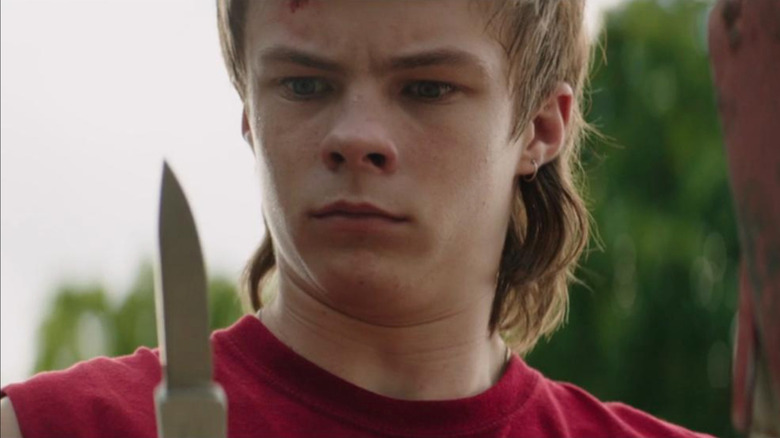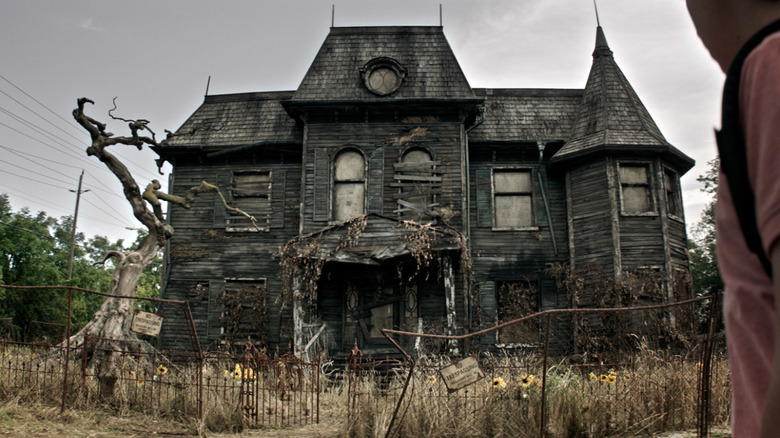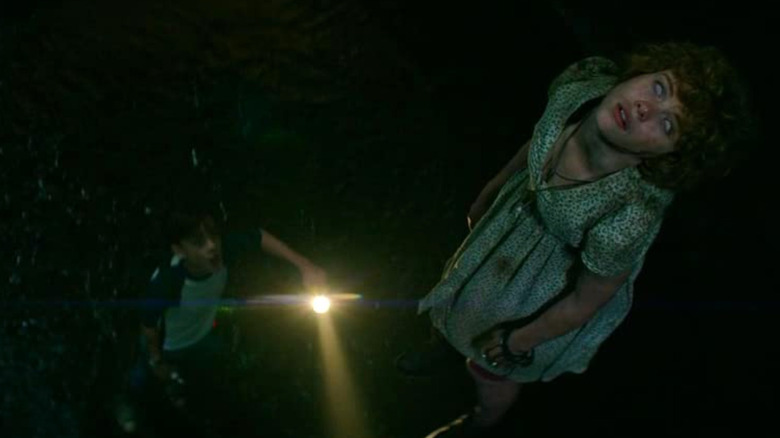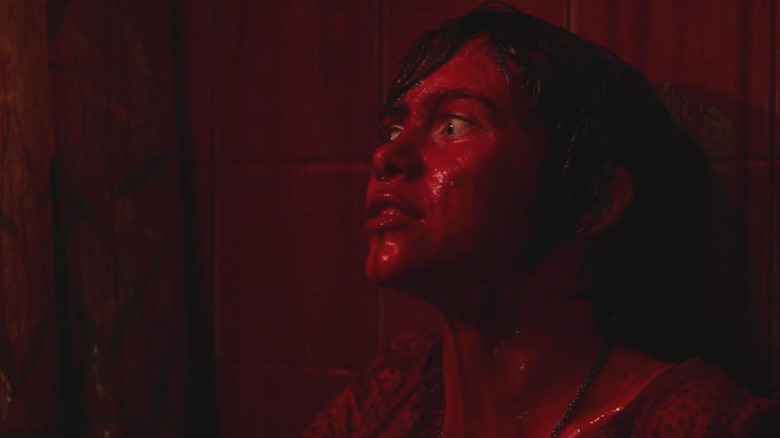Explaining All Of The Powers Of Pennywise
No creature has dominated the cultural landscape quite like Pennywise the Dancing Clown. The shapeshifting monster is the central villain in Stephen King's 1986 horror masterpiece "It," with a persona as nebulous as his story's title. The otherworldly being lives deep within the foundations of Derry, Maine, a town cursed with his pervasive evil and a frequent setting in King's canon. Pennywise emerges every 27 years to feast on Derry's children, and this time he's set his sights on the Losers Club. Outcasts Bill Denbrough, Mike Hanlon, Richie Tozier, Eddie Kaspbrak, Stanley "Stan" Uris, Ben Hanscom, and Beverly Marsh form a strong bond that enables them to square off against the murderous clown. They temporarily defeat Pennywise in childhood, but must return to Derry as adults to finish him off once and for all.
While Pennywise hides behind many faces, his power to terrify audiences is readily apparent. Director Andy Muschietti's 2017 adaptation "It" remains the highest-grossing horror movie of all time and is thought to have spawned an outbreak of real-world clown sightings throughout the United States. Muschietti cast Bill Skarsgård to fill the floppy shoes in both "It" and the subsequent sequel "It Chapter Two," with a look harkening back to the Renaissance, Elizabethan, Victorian, and even Medieval eras of centuries past. But aside from his sinister grin, what makes Pennywise so terrifying is his multifaceted abilities. Not bound by the limits of physical reality, the terrifying creature has a plethora of deadly powers he employs to hunt the children of Derry.
Lurking in the shadows
Pennywise's presence can be felt throughout Derry, and the terrifying monster has a knack for appearing in the strangest places. Though the novel's opening chapter is known for the awful death of Georgie Denbrough, his horrific end is preceded by a much quieter but equally ominous scare. Georgie goes into his basement for paraffin wax, needed to waterproof his paper sailboat. While making his way through the dark cellar, he notices a pair of glowing eyes watching him patiently as if preparing to strike. Turning on his flashlight reveals an ordinary shelf, but Georgie is thoroughly spooked. He hurries upstairs thinking he's made his way to safety.
Pennywise frequently lurks in shadows and dark corners, making his presence known and then quickly withdrawing again. When Mike makes a delivery to Derry Quality Meats, he first sees what appears to be a clown dangling from a meathook, obscuring what is likely just an animal carcass. This deceptive practice has several benefits for a monster who feasts on fear. It causes his victims to doubt their perception, making them more vulnerable to his direct attacks. These subtle appearances also create a general feeling of unease, leaving the residents of Derry constantly on edge. It's a tactic Pennywise has been employing for decades. As Ben's research shows, Pennywise has been hiding in plain sight, frequently lurking within images from Derry's past and waiting for the perfect moment to strike.
Body contortion
One of Pennywise's more disturbing characteristics is his ability to transcend the laws of physics. He can bend and contort his body at will, fitting into tiny spaces or expanding to dominate a room. A spectacular demonstration of this power occurs in the decrepit house on Neibolt Street. After falling through the crumbling floor, Eddie stares in shock at his badly broken arm, when an old refrigerator door opens across the room. Inside lies a jumble of body parts surrounding Pennywise's twisted head. The clown slowly unpacks and unfolds his limbs until he stands fully intact inches from the helpless child. The effect was accomplished almost entirely through CGI, and provides a nightmarish glimpse into the depths of his powers.
This ghastly ability is also the clincher for one of the most heartbreaking deaths in the series. After losing his arm to the menacing clown, Georgie attempts to crawl away to safety. He would likely survive was it not for the clown's malleable nature. As the boy inches across the street, the clown's arm slowly extends out of the sewer drain and into the middle of the street, grabbing Georgie and pulling him into the depths of the sewers. Director Andy Muschietti has said this was one of the most difficult scenes to shoot, but it perfectly sets the deadly tone and presents a monster from which there is no escape.
Sending a message
Always one to play with his food, Pennywise loves to send messages to the Losers. After capturing Beverly in "It," Pennywise leaves a message written in blood on her bathroom wall: "You die if you try." The cheeky phrase is intended both to intimidate Bill and warn him away from trying to rescue his friend. Or, perhaps his intention is to challenge the group's de facto leader and cause him to bring the rest of the Losers Club to fight the clown on his home turf.
Most of these messages occur in the sequel film "It Chapter Two." Having been defeated by the seven friends in a previous cycle, Pennywise has been nursing a grudge for 27 long years and is anxious for another chance to destroy them. The second film opens with an ominous command. "Come Home" is written in blood on the side of a bridge after the tragic death of Adrian Mellon. But perhaps the most memorable message occurs during dessert at the Losers' reunion dinner. Nightmarish fortune cookies each contain slips of paper each with a single word. Combined, they read, "Guess Stan couldn't cut it," a heartbreaking statement meant to inform them that their childhood friend died by suicide rather than come back to face the devious monster.
If you or anyone you know is having suicidal thoughts, please call the National Suicide Prevention Lifeline at 1-800-273-TALK (8255).
Shapeshifting
Pennywise's signature power is the ability to shift into any shape the mind can imagine. It is actually an entity from another world with a true form that is too complex for the human mind, a spider being the closest option. His default persona during the Losers Club era is the iconic clown, but he originally took the form of an eagle to menace the people indigenous to the land on which Derry now sits. Pennywise appears as many things throughout the story, including a werewolf, a leper, a mummy, an old woman, and a giant statue of Paul Bunyan. During the conclusion of "It," Pennywise rapidly changes into a succession of faces all designed to intimidate the person directly attacking him at any given moment. In the conclusion of "It Chapter Two," he sprouts long tentacles and spider-like legs, a nod to the novel's original conclusion.
One of the most frightening forms appears in "It" and even managed to scare Stephen King. Preparing for his bar mitzvah, Stan finds himself alone in his father's office with a creepy painting of an elongated woman holding a flute. The portrait falls face down on the floor and Stan rehangs it, only to find an empty frame and the woman playing her haunting melody in the shadows behind him. Inspired by an incident from his childhood, director Andy Muschietti incorporated this nightmare into the story exponentially upping the fear factor.
Teeth
While not necessarily a power, Pennywise has one particularly terrifying physical feature. Hidden within his sinister smile is a multitude of needle-like teeth. King has often written about teeth filed to cannibal points and that's just how Pennywise uses his. In his introductory scene in "It," the clown grabs Georgie's arm and then distends his jaw to reveal several rows of dagger-sharp teeth. He severs the poor boy's arm before dragging him into the sewer and presumably devouring him. These fangs can also be seen under the Kissing Bridge in "It Chapter Two" as Pennywise holds a dying Adrian Mellon and takes a bite out of his torso. In order to subdue his prey, Pennywise opens his face to reveal a glowing force known as the Deadlights surrounded by endless rows of these dental daggers.
The actual teeth seen in the films are prosthetics, apparently causing actor Bill Skarsgård to drool profusely, but the smile that surrounds them is frighteningly real. Skarsgård spent considerable time creating the sinister grin, combining imagery from hyenas and grizzly bears with an ability to point his lower lip honed as a child. Skarsgård remembers using this face to scare his younger brother, an ironic training ground for the child predator he would eventually portray.
Infecting the adults
The response of most children, when confronted with a monster, is to find safety with an adult. This is, unfortunately, not a luxury the children of Derry can afford. The adult citizens are rarely of help and are often dangerous themselves. Ben's research confirms an extraordinarily high rate of disappearances within the town, but these crimes rarely phase the adult citizens. This is likely due to It's lair, located in the bowels of the town. His evil pervades the thoughts and actions of its older residents.
This ambivalence is present in the opening scene of "It" as an old woman turns away from Georgie talking to a sewer drain. She then returns to find the boy missing and the street filled with blood. She apparently does not report the incident and Georgie is considered missing. Later, when local bully Henry Bowers attempts to carve his name into Ben's stomach, a car passes by, a red balloon in the backseat signaling their indifference. Perhaps the most egregious example of these awful adults, though, is Beverly's father Alvin Marsh. He cruelly blames her for her mother's death and constantly makes inappropriate comments, clearly implying his intent to assault her when she gets a little older.
If you or anyone you know has been a victim of sexual assault, help is available. Visit the Rape, Abuse & Incest National Network website or contact RAINN's National Helpline at 1-800-656-HOPE (4673).
If you or someone you know may be the victim of child abuse, please contact the Childhelp National Child Abuse Hotline at 1-800-4-A-Child (1-800-422-4453) or contact their live chat services.
Malevolent balloons
One of Pennywise's most visually arresting talents is his ability to manipulate red balloons. Often appearing as a harbinger of his presence, they are seemingly unbound by the laws of physics and can float against the wind, grow to massive size, and appear out of thin air. These balloons are usually only visible to his intended victims, imperceptible to those around them. Ben notices a balloon dragged horizontally across the library as if with invisible hands minutes before he is attacked by Pennywise. Shortly after Adrian Mellon dies, red balloons cascade from the underside of the bridge like massive streams of blood.
These balloons often serve a practical purpose to the malevolent clown. Psychotic bully Patrick Hockstetter is distracted by a red balloon in the sewers, leaving him vulnerable to It's attack. Henry Bowers finds the knife he uses to kill his father in his mailbox marked with the signature orb. In one memorable scene from "It Chapter Two," Pennywise glides through the air toward Richie, kept afloat by an eerily symmetrical bunch. In fact, the red balloon has become so synonymous with the murderous clown that it's been heavily featured in the promotional artwork for both films. One fan theory supposes the balloons actually contain the souls of Pennywise's victims, adding an ominous tone to his oft-repeated warning, "You'll float too."
Controlling media
Not content to only appear in person, Pennywise has an unsettling habit of haunting books, flyers, and other forms of physical media. Ben's library book about the history of Derry contains a series of pages with increasingly enhanced images that slowly reveal the severed head of a little boy killed in an explosion. The boy's reanimated body proceeds to attack Ben in the basement archives. Even more ominous is the children's TV show many kids of Derry can be seen watching in "It." Delivering unsettling messages, the female host informs her viewers about the joys of playing the sewers and later directly commands Henry Bowers to kill his father. These examples are often designed to intimidate It's potential victims, like the missing poster Richie finds featuring a picture of himself apparently taken that same day.
This power manifests in one memorable scene from "It." After the kids look at slides of Derry to plan their attack, the projector malfunctions and rapidly displays a series of Bill's family photos. Seeming to freeze on one image, the hair covering Mrs. Denbrough's face slowly blows back to reveal the malevolent visage of Pennywise. The screen then flashes on an empty frame and a now giant clown bursts through the screen and crawls towards Beverly. Hoping to capture authentic reactions, this scene marked the first time the child actors actually saw Bill Skarsgård in his full Pennywise costume, adding oomph to what is already the most effective sequence of the movie.
Setting the mood
Pennywise has a flair for the dramatic and often delights in creating terrifying environments for his potential victims. This power is first hinted at in "It" with the iconic death of Georgie. Appearing in the sewer, Pennywise is able to evoke the sounds and even smells of the circus for the young child to put him at ease given that he's talking to a clown in a sewer. Later, when Ben follows a trail of Easter eggs into the library's deserted archives, the lights begin flashing, making his dash through the stacks especially scary. Additionally, a room in the house on Neibolt Street contains a multitude of clown statues surrounding a child-sized coffin with a doll of Richie lying within. In another scene, Beverly's bathroom is covered with a torrent of blood spewing from the drain that only the Losers can see.
Furthermore, though the sinister house on Neibolt Street is already frightening enough, one room contains three doors posing a terrifying dilemma. Each door is labeled with a promise of what's inside: "Scary," "Very Scary," and "Not Scary At All." Within, they find various frightening images from the dismembered body of Betty Ripsom, another missing child, to a deceptive Pomeranian whose bark unleashes a deadly monster. While in his lair, Pennywise puts on a devilish show of music and dancing for Beverly before confessing his love for, "Tasty, tasty, beautiful fear," using these theatrics to increase his victims' terror, thus flavoring the meat.
Conjuring the dead
One of Pennywise's most devastating powers is a variation of his shapeshifting. He is able to conjure the dead, adding emotional turmoil to an already frightening scene. Once a person dies in Derry, they seemingly become fair game for the flamboyant monster. Patrick Hockstetter finds this out firsthand while chasing Ben through the sewers in "It." Hearing whispers, he lights his makeshift flamethrower to reveal the decomposing corpses of the Derry kids who've recently gone missing. They chase him into a dead-end of the sewer where he is devoured by Pennywise. Hockstetter's own reanimated corpse is featured in "It Chapter Two," first handing an adult Henry his trusty switchblade, then driving the getaway car as he breaks out of the facility in which he's been committed. Beverly also hears the voices of these children in the drain of her bathroom sink before the tendrils of hair emerge and try to drag her in.
This power takes a devastating turn as Pennywise also conjures the image of Georgie to further torture Bill. He appears as the ill-fated little brother several times throughout the story, intentionally amplifying Bill's guilt and grief. In another emotional tactic, Pennywise takes the form of Stan's severed head. Emerging through the floorboards of the sinister house on Neibolt Street, he first blames Bill for his death then sprouts spider legs from his face before skittering toward the group.
Manipulating killers
One might think that simply avoiding Pennywise would be enough to stay safe in Derry, but the clown has a number of tricks up his sleeves, some involving the town's citizens. It is capable of manipulating the people of Derry, often causing them to do his bidding. The most notable example of this manipulation is Henry Bowers who serves as a kind of henchman for It. Henry is more than an average bully, constantly attacking the Losers. Guided by Pennywise, he murders his abusive father by unloading his switchblade into the sleeping man's neck. As an adult, he breaks out of a mental health facility determined to finally kill the Losers Club. Pennywise essentially orchestrates his escape, sending the corpse of Patrick Hockstetter to wait outside with a getaway car.
Pennywise's evil has an indirect effect on the citizens of Derry as a whole, a cursed town full of angry and violent people, as seen with the death of Adrian Mellon. "It Chapter Two" opens with a brutal hate crime as a group of teens hurl homophobic slurs at Adrian and his boyfriend before beating him and then throwing him off a bridge into the water below. Though never explicitly stated, it is implied that this violence happens as a result of the underlying hatred in Derry itself. This does not excuse the teenagers' heinous actions, but it does inform some of the anger they carry.
If you or a loved one has experienced a hate crime, contact the VictimConnect Hotline by phone at 1-855-4-VICTIM or by chat for more information or assistance in locating services to help. If you or a loved one are in immediate danger, call 911.
If you or someone you know may be the victim of child abuse, please contact the Childhelp National Child Abuse Hotline at 1-800-4-A-Child (1-800-422-4453) or contact their live chat services.
Black goo
Red balloons and lurking monsters are not the only devious creatures Pennywise is capable of conjuring. His presence is occasionally signaled by a thick black goo with mysterious properties. The slimy substance first appears in the house on Neibolt Street. An image of Eddie's decapitated head bursts through a dirty mattress and then spews the disgusting liquid all over the floor. Possibly acidic, it propels Bill and Richie through the house, forcing them to choose between one of three ominous paths forward. An addition to Stephen King's original story, the liquid could be a subtle nod to another one of King's tales. "The Raft," published in the short story collection "Skeleton Crew," features a similar slick of oil floating on an October lake with the power to dissolve anything it touches.
The goo is also a presence in one of the most disgusting scenes in "It Chapter Two." After a reunion dinner at Jade of the Orient in which the old friends reconnect and bond over happy memories, they're treated to a nightmarish dessert. The dark slime slowly begins to spread across the table as their fortune cookies burst open with tiny monsters. Each contains something disgusting, from a malformed fly with the screaming head of a baby to a crawling eye that uses its blood vessels to propel it forward. Seemingly powered by the goo, they explode onto the table unleashing these nightmares only visible to members of the Losers Club.
The cycles
Though its evil pervades the town of Derry creating a distinctly unpleasant environment, the residents occasionally catch a bit of a break. Pennywise functions on a cycle spanning roughly 27 years that has been presumably repeating itself for centuries. Each new cycle is born with a shocking act of violence. The death of Georgie Denbrough begins the 1989 cycle and Adrian Mellon's murder is the instigator of the modern cycle. Once in full swing, Derry is beset with a series of child murders and disappearances culminating in a large-scale tragedy. Finally full, It retreats into his lair for another long slumber.
Though Andy Muschietti's films cast Ben as the original Derry historian, Stephen King's original novel gives Mike the task of chronicling town events. Not sure they've definitely killed the nightmarish clown, he is wary of another cycle beginning and dreads having to call in the promise they made as children to come back and finish the job. King's novel contains an extensive exploration of previous cycles in sections called Interludes. In preparation for a new round, Mike has collected stories about mass murders, vanishing settlements, a racially motivated fire, and a deadly explosion during a children's Easter egg hunt all occurring within the Derry town limits. The HBO prequel series "Welcome to Derry," will reportedly be set in the 1960s, placing it roughly one cycle ahead of the one featured in "It," teasing more of the town's dark history.
The Deadlights
Pennywise's most insidious faculty is also the most difficult to explain. Though he often appears as a clown, his true form is a source of eldritch power known as the Deadlights. Depicted as three glowing lights in director Andy Muschietti's film "It," the Deadlights are a nebulous source of energy connected to a larger dimension called the Macroverse. Also referred to as Todash in Stephen King's "The Dark Tower" series, this is a sort of liminal space between worlds filled with lurking monsters waiting for their chance to break free.
Pennywise uses the Deadlights as a sort of hypnosis, meant to incapacitate his prey for later consumption. Unhinging his jaws, he opens his face to reveal a long, tooth-lined tunnel surrounding the glowing orange lights. Beverly is the first of the Losers to become trapped in the Deadlights. Looking at the mesmerizing glow, her face slackens and a senseless white sheen slips over her eyes. Beverly begins to float several feet off the ground among the other victims in Pennywise's lair. Richie is also caught in the Deadlights in the conclusion of "It Chapter Two" and made to replicate Pennywise's sinister dance. The Losers combat the Deadlights with the Ritual of Chud, a metaphysical way of matching wits with the centuries-old demon. While Muschietti's ritual differs dramatically from King's, both involve overpowering the monster by forming a cosmic connection both with It and with each other.
Emotional manipulation
Pennywise's most upsetting power lies in his ability to manipulate the emotions of his intended victims. This innate ability to identify someone's deepest fears also allows him to access and exploit their internal feelings of guilt, shame, and loss. Mike first encounters It as badly burning hands, reminiscent of the house fire that killed his parents when he was a child. Bill is manipulated by the ghost of Georgie several times throughout the series. In "It Chapter Two," Pennywise tries to disarm Bill by accusing him of causing Georgie's death by lying about how sick he was on the day of his brother's death.
Once again, Beverly's father provides the most chilling manifestation of this power. Still grieving the death of his wife, he constantly makes inappropriate advances at his pre-teen daughter and is seemingly days away from escalating to physical abuse. The blood Pennywise sends to her through the drain in her bathroom is a representation of her upcoming first menstruation, signaling a dangerous phase of maturity in which she will be most attractive to her father. Pennywise occasionally appears to Beverly disguised as her father, most notably in the climactic sewer battles that conclude both films. But it is Beverly's fearlessness in the face of her trauma that allows her to strike the decisive blow, forcing It back into his lair for the next 27 years.
If you or anyone you know has been a victim of sexual assault, help is available. Visit the Rape, Abuse & Incest National Network website or contact RAINN's National Helpline at 1-800-656-HOPE (4673).
If you or someone you know may be the victim of child abuse, please contact the Childhelp National Child Abuse Hotline at 1-800-4-A-Child (1-800-422-4453) or contact their live chat services.
